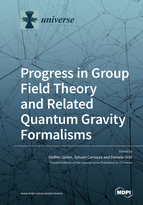Progress in Group Field Theory and Related Quantum Gravity Formalisms
A special issue of Universe (ISSN 2218-1997).
Deadline for manuscript submissions: closed (30 June 2019) | Viewed by 46923
Special Issue Editors
Interests: quantum gravity; quantum cosmology; group field theory
Interests: quantum gravity; quantum field theory; mathematical physics; quantum foundations
Special Issue Information
Dear Colleagues,
In recent years, the Group Field Theory (GFT) formalism for quantum gravity has seen significant progress in different directions: Our understanding of its quantum geometric degrees of freedom has been deepened, new techniques have been developed towards GFT renormalization, and the possibility of establishing a continuum limit; new connections between quantum gravity, condensed matter physics and quantum information have been explored; applications of GFT to the physics of cosmology and black holes point to possible novel resolutions of puzzles of classical gravity and represent promising avenues for connecting quantum gravity with observations. The many (conceptual and mathematical) relations and structural overlaps with other quantum gravity formalisms, such as random tensor models, loop quantum gravity, and lattice gravity, allow also to take advantage of the many developments occurring in them, which include both interesting results of direct implementation within GFT as well as inspiring advances towards shared goals. This stimulates mutual and joint progress.
This Special Issue focuses on GFT, and more broadly on related formalisms which share the same methods and foundations. Contributions from tensor models, loop quantum gravity, spin foam models, or other discrete and combinatorial approaches to quantum gravity which have direct implications for GFT will be particularly welcomed. We also encourage submissions from research fields with direct relevance to more specific aspects of GFT research, including for instance fundamental cosmology, quantum information, or condensed matter theory, but also mathematical and formal aspects.
Research papers or review articles are welcome.
No Article Processing Charges (APC) will be applied to submitted manuscripts. If the Special Issue reaches more than 10 published papers, it will be printed in book form, with an ISBN number.
Dr. Steffen Gielen
Dr. Sylvain Carrozza
Dr. Daniele Oriti
Guest Editors
Manuscript Submission Information
Manuscripts should be submitted online at www.mdpi.com by registering and logging in to this website. Once you are registered, click here to go to the submission form. Manuscripts can be submitted until the deadline. All papers will be peer-reviewed. Accepted papers will be published continuously in the journal (as soon as accepted) and will be listed together on the special issue website. Research articles, review articles as well as short communications are invited. For planned papers, a title and short abstract (about 100 words) can be sent to the Editorial Office for announcement on this website.
Submitted manuscripts should not have been published previously, nor be under consideration for publication elsewhere (except conference proceedings papers). All manuscripts are thoroughly refereed through a single-blind peer-review process. A guide for authors and other relevant information for submission of manuscripts is available on the Instructions for Authors page. Universe is an international peer-reviewed open access monthly journal published by MDPI.
Please visit the Instructions for Authors page before submitting a manuscript. Submitted papers should be well formatted and use good English. Authors may use MDPI's English editing service prior to publication or during author revisions.
Keywords
- quantum gravity
- group field theory
- tensor models
- spin foam models
- loop quantum gravity
- quantum cosmology








